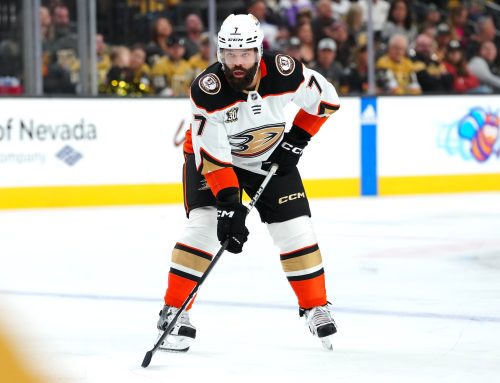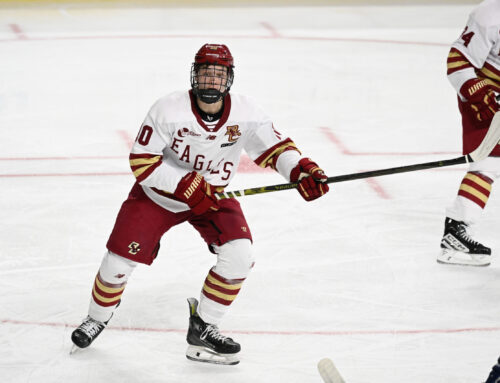
Last Friday, the Buffalo Sabres announced that winger Jeff Skinner had signed an eight-year extension carrying an average annual value of $9-million. Naturally, there was a little bit of hubbub when this was announced.
Let’s take a look at Skinner and his value step by step. This isn’t directly fantasy-related and I do apologize for that but I feel the need to offer the other side of the coin here. It is a good exercise in trying to account for context however, and that is very important for fantasy.
For Dobber’s take on the contract, read here.
For Ian’s take on the deal, fantasy analysis included, read here.
Goal Scoring
Since entering the league, the diminutive winger is tied for 13th in goals league wide with 244. The list of names ahead of him include the most elite offensive players in hockey and some future Hall of Famers like Malkin, Crosby, and Kane. They also include wingers who scored about as often as he did in Jamie Benn (259) and Corey Perry (254). But that doesn’t really do him justice because of both the team he was playing for and the minutes he played. For example, Steven Stamkos played 225 more minutes than Skinner over those nine seasons despite 76 fewer games played. That is nearly an extra season’s worth of ice time for Stamkos over Skinner in those nine years. Now, Stamkos is clearly the more valuable player overall, but Skinner scored 143 goals at five-on-five over his eight years in Carolina. The next two highest scorers for Carolina – Eric Staal and Jiri Tlusty (seriously) – combined for 134. In those eight seasons, Skinner was tied for 6th league-wide in goals/60 at five-on-five, trailing only Stamkos, Rick Nash, Vladimir Tarasenko, Evgeni Malkin, and Nikita Kucherov. Yes, on a per-minute rate at 5v5, over eight seasons, Skinner outscored Alex Ovechkin.
I know some people may clamour that Skinner’s TOI was low because he didn’t penalty kill, but from 2014-17, Skinner was outside 70th percentile in five-on-five ice time league-wide. This was largely a time when it seemed everyone was concerned about his injury history, but it still remains that he was an elite goal scorer who just wasn’t getting the ice time that many elite goal scorers do.
And that’s a funny thing considering the team he was playing for, right? Excluding teams that were introduced or relocated in that time, the only teams that scored less often than Carolina in those eight years were Los Angeles, Edmonton, Florida, Arizona, New Jersey, and Buffalo. Over the three years in the sample outlined in the paragraph above, the Hurricanes ranked 27th. This is a team that needed all the goal scoring it could get and would not give Skinner the ice time he commanded, for one reason or another.
So we know Skinner is one of the best goal scorers in the world and could probably have used more ice time in Carolina. What else?
Defensive Ability
It should be mentioned that Skinner isn’t very good defensively. He’s below average, in fact:

Red in the defensive zone is bad, so we can tell pretty easily that he isn’t good defensively. The thing is, not many players are great both offensively and defensively, and when discussing wingers, we're discussing a handful of players like Mark Stone, Brendan Gallagher, and Nino Niederreiter, and even Nino had a bit of a down year in 2018-19, comparatively speaking. “He plays a 200-foot game” is a common refrain that, in reality, just isn’t very common. We’ll get back to Stone in a minute.
To visualize what it looks like, here are Skinner’s most recent three seasons by offensive play-driving and defensive ability over the last three years from Evolving Hockey:
.png)
Elite offensively, below-average defensively.
Overall Impact
If we want to try to encompass everything Skinner does – he’s one of the best in the league at drawing penalties, for example – we can use things like Evolving Hockey’s Goals Above Replacement (GAR) model. It helps measure overall impact, from offence and defence, to special team proficiency, penalty drawing/taking, and all that those things entail. The numbers highlighted on the far left represent rank league-wide among forwards with 2000 minutes at even strength over the last three years. The numbers on the right represent total GAR:

When taking Skinner’s impact in totality, he’s been about as valuable as Tarasenko, and that’s despite Skinner’s issues defensively. That’s how good he is both offensively and at drawing penalties (an underrated yet critical skill).
It’s not meant to say Skinner is better than Tarasenko, but GAR says that we should at least be viewing them as similar players in terms of value. Nothing more, nothing less.
The point on drawing penalties is something that can sometimes get overlooked but is important. Not only does Skinner draw a lot of penalties – 12th-most over the last three years, per 60 minutes – but he doesn’t take many either, finishing about the middle of the league in that span in this regard. All told, Skinner’s penalty differential (penalties drawn less penalties taken) was the fourth highest over the last three years (plus-42), behind only Johnny Gaudreau (plus-69), Connor McDavid (plus-67), and Aleksander Barkov (plus-49).
So, if we were to summarize what we know about Skinner to this point, it’s this:
- He’s an elite goal scorer
- He’s elite at creating power play opportunities
- He’s below-average defensively
Let’s talk about his shooting this year.
Shooting Percentage
One criticism often cited is that of Skinner’s shooting percentage. Yes, his 14.9 percent in 2018-19 was a career high. He also shot 14.4 percent in his rookie year and had three seasons in Carolina of at least 12 percent. Remember that Carolina struggled to score in Skinner’s tenure and was 28th in shooting percentage in the NHL over his eight years, lower than teams like Arizona and Los Angeles.
We need to look at how he got to that 14.9 percent. For the season, Skinner shot 13.8 percent at five-on-five. That, by the way, is not a career high, as he shot 15 percent at five-on-five in his rookie season. He also shot 12.6 percent two years ago. That mark of 13.8 percent in 2018-19, among 131 forwards with at least 1000 minutes at 5v5, was 27th.
On the power play, Skinner actually shot lower than he did at 5v5, coming in at 13.6 percent (which, by the way, wasn’t the highest or even the second-highest mark of his career). Among 171 forwards with 125 minutes on the power play, Skinner finished 98th in shooting percentage.
So, at five-on-five, Skinner finished just outside the 80th percentile of heavily-used (and healthy) forwards. On the power play, he was in the bottom half of the league. It was a career-high shooting percentage at all strengths, but this isn’t William Karlsson from 2017-18. We’ve seen percentages like this from him before.
On shooting percentage: five years ago, Eric Tulsky (who, funnily enough, now runs the analytics department for Carolina) found that shooting percentage basically starts declining among forwards at about age 25 and declines until they retire. However, steep, annual decline usually doesn’t start until a player hits their mid-30s. Whether Skinner follows this trajectory is completely unknowable, and maybe things have changed in the seasons since, but it should give some pause from people concerned he’ll fall off a cliff in two years.
Now we get to Buffalo’s situation.
The Sabres
They effectively had three options: let him walk, trade his rights (as Winnipeg did with Kevin Hayes), or sign him. Let’s assume that they were never going to trade his rights, so it’s either sign him or let him go.
If they let him go, the team that was 21st in goals/60 at all strengths this year now has to replace him. They can’t really do it internally with the lack of elite forward prospects in their system right now – and I’m not considering Casey Mittelstadt a prospect anymore. They then have to look externally, almost certainly via free agency because I don’t see them trading what few trade chips they have left for an elite scoring winger. It’s a pretty good year in the winger free agency pool with names like Joe Pavelski, Anders Lee, Artemi Panarin, Jordan Eberle, and Gustav Nyquist, among others. Of course, the gamble is that Buffalo would be able to sign any of them. Pavelski and Lee could return to their teams and others could choose elsewhere. In recent seasons, there hasn’t exactly been a lineup to go to Buffalo as a free agent. At least not since Kyle Okposo, anyway. After the off-season upheaval and years of toiling in the basement, even with Jack Eichel and Rasmus Dahlin around, is there any sort of guarantee they could get someone like Panarin, and at a number that isn’t an overpayment? Of course not.
Finally, let’s bring this back to Stone. He’s in a similar boat as Skinner in that he was traded to a team making a push and eventually re-signed with said team. His contract carries an AAV only $500K higher than Skinner’s, and that probably puts Vegas in a good light here. In comparison to Stone, Skinner’s deal is an overpayment. Or Stone’s contract is an underpayment. Either/or.
(Just as a small aside, the two wingers mentioned at the start of the article as guys who’ve scored about as often as Skinner since 2010 – Jamie Benn and Corey Perry – have contracts of eight years with a $9.5M AAV and eight years with an $8.625M AAV, respectively.)
I am willing to admit that I think this is an overpayment and the guys at Evolving Wild had Skinner’s projected contract at eight years with roughly an $8.5M AAV. Skinner was going to get paid handsomely, and Buffalo was the one who decided to give him that contract. It might be about $1M too much in AAV but it’s better to overpay your stars than it is the guys in your bottom-6 (looking at you, Vancouver and Detroit).
I realize I’m in the minority here but I do think Skinner, today, is one of the 15 or so best wingers in the NHL, and he scores piles of goals: since 2010, he’s one of 15 players with at least four separate 30-goal seasons. Other wingers with four such seasons: Benn, Marchand, and Kessel.
Goal man gets paid.
Whether he’s worth it in a cap league format is another issue entirely, and I’ll leave that to Alex MacLean, who is going to cover it a little later this week in his ‘Capped’ column.
All this, of course, doesn’t mention that Skinner went from playing with Derek Ryan and Victor Rask to playing with Jack Eichel; from 2015-2018, Skinner played nearly 2350 of his 3412 with either Ryan or Rask, or both. In that time, he put up the same goals/60 minutes at 5v5 rate as Malkin, and a higher rate than names like Kucherov, Marchand, and Pastrnak.
Again, for emphasis, he did this with Victor Rask and Derek Ryan.
As to whether Skinner repeats the 40-goal performance, I don’t know. Repeating 40-goal seasons for anyone not named Alex Ovechkin is incredibly hard to do. But I don’t think this contract is nearly as bad as some corners of the hockey community are making this out to be. I’ll be more than willing to admit I’m wrong in five years should that be the case.





 FLA
FLA CHI
CHI NYR
NYR PIT
PIT L.A
L.A COL
COL CAR
CAR UTA
UTA SEA
SEA
 NYI
NYI TOR
TOR N.J
N.J MTL
MTL
